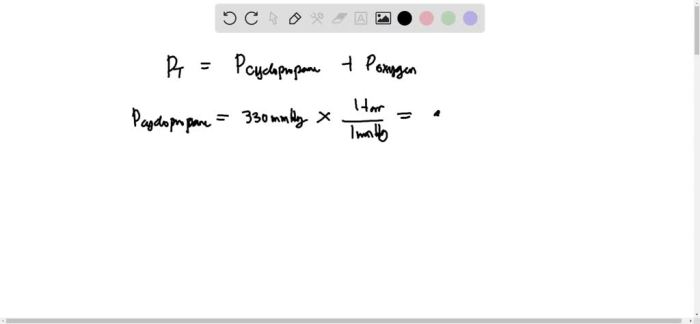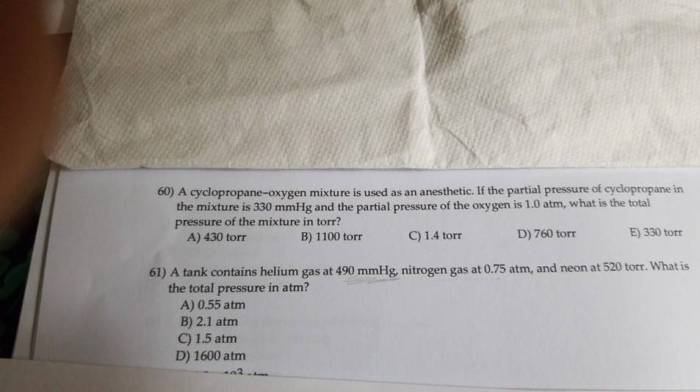A cyclopropane-oxygen mixture is used as an anesthetic – A cyclopropane-oxygen mixture has been utilized as an anesthetic, offering unique advantages and considerations in the field of anesthesia. This mixture has a rich history, and its properties, administration techniques, and safety aspects are crucial for medical professionals to understand.
Cyclopropane, a cyclic hydrocarbon, exhibits high flammability and reactivity. As an anesthetic, it induces rapid induction and recovery, making it suitable for short surgical procedures. However, its potent effects necessitate careful monitoring and precise administration.
Definition of Cyclopropane

Cyclopropane is a cyclic hydrocarbon with the chemical formula (CH 2) 3. It is a colorless, flammable gas with a sweet, pungent odor.
Cyclopropane is the smallest cyclic alkane, and its molecular structure is a three-membered ring. The carbon atoms in the ring are sp 3hybridized, and the C-C-C bond angles are 60°. This makes cyclopropane a highly strained molecule, and it is therefore very reactive.
Cyclopropane as an Anesthetic
Cyclopropane was first used as an anesthetic in 1934. It quickly became popular because it is a potent anesthetic with a rapid onset of action and a short recovery time.
Cyclopropane is a general anesthetic, which means that it produces unconsciousness and pain relief. It works by depressing the central nervous system. Cyclopropane is more potent than ether, but less potent than halothane. It has a rapid onset of action, and patients typically lose consciousness within 30 seconds of inhaling the gas.
Cyclopropane is also a potent respiratory depressant. This means that it can slow down breathing, and in some cases, it can even stop breathing altogether. Therefore, cyclopropane must be administered by a qualified anesthesiologist who can closely monitor the patient’s breathing.
Oxygen in the Cyclopropane-Oxygen Mixture: A Cyclopropane-oxygen Mixture Is Used As An Anesthetic

Cyclopropane is not flammable in air, but it is flammable in oxygen. Therefore, cyclopropane is always mixed with oxygen when it is used as an anesthetic. The concentration of oxygen in the cyclopropane-oxygen mixture is typically between 20% and 40%.
The oxygen in the cyclopropane-oxygen mixture serves two purposes. First, it prevents the cyclopropane from igniting. Second, it provides oxygen to the patient, which is necessary for maintaining life.
Administration of the Cyclopropane-Oxygen Mixture

Cyclopropane is administered via inhalation. The patient is typically given a mask or mouthpiece to breathe through, and the cyclopropane-oxygen mixture is delivered through the mask or mouthpiece.
The anesthesiologist will closely monitor the patient’s breathing and vital signs during the administration of cyclopropane. The anesthesiologist may also need to adjust the concentration of oxygen in the cyclopropane-oxygen mixture to maintain the desired level of anesthesia.
Alternatives to the Cyclopropane-Oxygen Mixture

There are a number of alternative anesthetic agents that can be used instead of cyclopropane. These agents include:
- Halothane
- Isoflurane
- Sevoflurane
- Desflurane
These agents are all less flammable than cyclopropane, and they have a longer duration of action. However, they are also more expensive than cyclopropane.
FAQ
What are the advantages of using a cyclopropane-oxygen mixture as an anesthetic?
Rapid induction and recovery, minimal nausea and vomiting, and bronchodilation.
What are the disadvantages of using a cyclopropane-oxygen mixture as an anesthetic?
High flammability, potential for cardiovascular depression, and increased risk of seizures.
How is the concentration of oxygen in the cyclopropane-oxygen mixture determined?
The concentration of oxygen is adjusted based on the patient’s condition and the desired level of anesthesia.